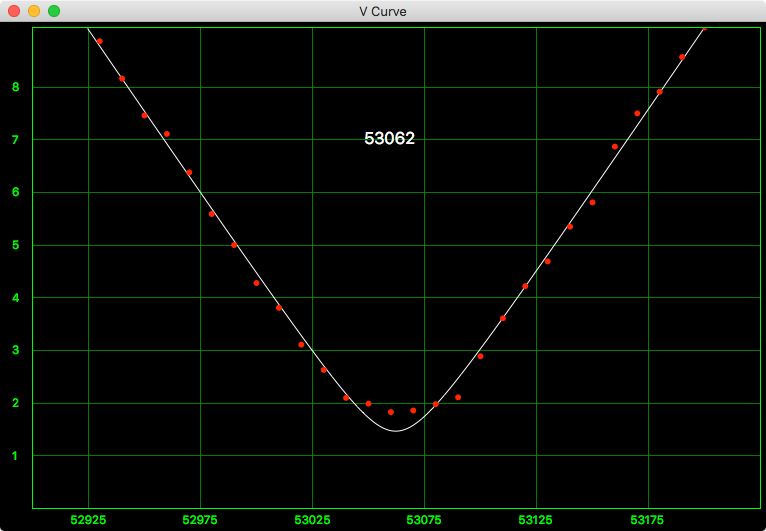beachbum I do have it set for 50 steps, and I am using APT...
No, don't rely on the default step size.
Next time you have dark skies, try to do a manual focus sweep, and measure the average FWHM or HFD of stars in the sensor frame for each of the focuser positions.
When you plot the FWHM by hand as you change the EAF setting, you should see a V curve that looks like this (my own focusing program for macOS):

Try to get a sweep that starts with a FWHM of over 8, let it go through focus and then watch it rise towards 8 again. If it keeps rising when you start, you are moving in the wrong direction.
Notice the minima where the curve shallows out (the curve transitions from the geometric optics region, hyperbola focus region with straight line sides) to the Fourier optics region (diffraction limited) where the FWHM does not change very much as you move the focuser.
The focus of a star does not improve around the "critical focus" region (surrounding 53062 in the horizontal axis in above diagram). Find out how many steps are in this region. A step size that traverses the critical focus region with one or two steps should be sufficient.
Conversely, you can also change your auto focus step size so that there are about 8 to 12 points in the curve where it starts at about 8 and come back up to about 8 again. Use one of these step sizes as your initial autofocus step size. You can fine tune later "to taste" once you have it working.
The above curve is a bit more oversampled than necessary; which does not do much harm except to waste your time while it autofocuses.
You may need to rinse and repeat a few times to discover a good step size for your specific optics, specific rack and pinion focuser, etc.
You do not need to sample the critical focus region very precisely. The aim of the V curve is to measure the larger HFDs (where the walls of the hyperbola are close to a straight line) to establish the minima of the hyperbolic curve.
Be sure never to move the EAF back and forth when you measure the V curve. Always move the EAF in only one direction, otherwise you will be faced with the backlash. See here for how much backlash I measured a little while ago with the new version of the EAF:
https://bbs.astronomy-imaging-camera.com/d/12562-5v-eaf-linearity-and-backlash
To remeasure the FWHM for a V curve, always start at some place higher up in steps and move down and only down. Or start at a low number and move up and only up. Don't mix them.
Likewise, after you have figured out the correct focus location, first move the EAF to the same staring point and move down (or) up to the target EAF step.
Don't worry if the data is a little noisy. When a second order curve fit (I used minimum mean square for my program) is made with 8 or 12 points, there will be plenty of extra data points to average out the noisy data.
I had used the average HFD measured by the Star Detect tools in ASIAIR to measure the star sizes. You can use any tool to measure the average FWHM or HFD.
Looking at your curve, where the data points are just wandering around FWHM of 1 and not moving up past an FWHM of 6 or 8, I suspect that either (1) your step size is way too small, or (2) you are not exposing for long enough and you are actually measuring the FWHM of hot pixels instead the FWHM of stars, or (3) you are exposing for too long, so that all the stars are saturated (so the FWHM can only be driven from remaining warm pixels). Case (3) is usually not a problem since a good program should still see dimmer stars and use their FWHM.
Quite often, a belt driven EAF on a helical focuser like the Askar ACL200, and an EAF driving an SCT focuser both need larger step sizes to see a V curve without going through a very large number of steps.
Chen